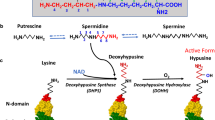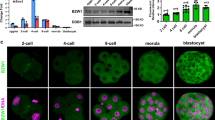Abstract
The eukaryotic initiation factor 5A (eIF5A) contains a polyamine-derived amino acid, hypusine [Nε-(4-amino-2-hydroxybutyl)lysine]. Hypusine is formed post-translationally by the addition of the 4-aminobutyl moiety from the polyamine spermidine to a specific lysine residue, catalyzed by deoxyhypusine synthase (DHPS), and subsequent hydroxylation by deoxyhypusine hydroxylase (DOHH). The eIF5A precursor protein and both of its modifying enzymes are highly conserved, suggesting a vital cellular function for eIF5A and its hypusine modification. To address the functions of eIF5A and the first modification enzyme, DHPS, in mammalian development, we knocked out the Eif5a or the Dhps gene in mice. Eif5a heterozygous knockout mice and Dhps heterozygous knockout mice were viable and fertile. However, homozygous Eif5a1 gt/gt embryos and Dhps gt/gt embryos died early in embryonic development, between E3.5 and E7.5. Upon transfer to in vitro culture, homozygous Eif5a gt/gt or Dhps gt/gt blastocysts at E3.5 showed growth defects when compared to heterozygous or wild type blastocysts. Thus, the knockout of either the eIF5A-1 gene (Eif5a) or of the deoxyhypusine synthase gene (Dhps) caused early embryonic lethality in mice, indicating the essential nature of both eIF5A-1 and deoxyhypusine synthase in mammalian development.




Similar content being viewed by others
Abbreviations
- eIF5A:
-
Eukaryotic translation initiation factor 5A
- DHPS:
-
Deoxyhypusine synthase
- DOHH:
-
Deoxyhypusine hydroxylase
- Eif5a :
-
Mouse gene encoding eIF5A-1
- Eif5a2 :
-
Mouse gene encoding the eIF5A-2 isoform
- ES cells:
-
Embryonic stem cells
- TCA:
-
Trichloroacetic acid
- DTT:
-
Dithiothreitol
References
Benne R, Hershey JW (1978) The mechanism of action of protein synthesis initiation factors from rabbit reticulocytes. J Biol Chem 253:3078–3087
Byers TL, Lakanen JR, Coward JK, Pegg AE (1994) The role of hypusine depletion in cytostasis induced by S-adenosyl-L- methionine decarboxylase inhibition: new evidence provided by 1- methylspermidine and 1, 12-dimethylspermine. Biochem J 303:363–368
Cano VS, Medrano FJ, Park MH, Valentini SR (2009) Evidence for conformational changes in the yeast deoxyhypusine hydroxylase Lia1 upon iron displacement from its active site. Amino Acids 38:479–490
Chatterjee I, Gross SR, Kinzy TG, Chen KY (2006) Rapid depletion of mutant eukaryotic initiation factor 5A at restrictive temperature reveals connections to actin cytoskeleton and cell cycle progression. Mol Genet Genomics 275:264–276
Chattopadhyay MK, Park MH, Tabor H (2008) Hypusine modification for growth is the major function of spermidine in Saccharomyces cerevisiae polyamine auxotrophs grown in limiting spermidine. Proc Natl Acad Sci U. S. A 105:6554–6559
Chen KY, Liu AY (1997) Biochemistry and function of hypusine formation on eukaryotic initiation factor 5A. Biol Signals 6:105–109
Clement PM, Johansson HE, Wolff EC, Park MH (2006) Differential expression of eIF5A–1 and eIF5A–2 in human cancer cells. Febs J 273:1102–1114
Gregio AP, Cano VP, Avaca JS, Valentini SR, Zanelli CF (2009) eIF5A has a function in the elongation step of translation in yeast. Biochem Biophys Res Commun 380:785–790
Guan XY, Fung JM, Ma NF, Lau SH, Tai LS, Xie D, Zhang Y, Hu L, Wu QL, Fang Y, Sham JS (2004) Oncogenic role of eIF-5A2 in the development of ovarian cancer. Cancer Res 64:4197–4200
Hanauske-Abel HM, Park MH, Hanauske AR, Popowicz AM, Lalande M, Folk JE (1994) Inhibition of the G1-S transition of the cell cycle by inhibitors of deoxyhypusine hydroxylation. Biochim Biophys Acta 1221:115–124
Hoque M, Hanauske-Abel HM, Palumbo P, Saxena D, D’Alliessi Gandolfi D, Park MH, Pe’ery T, Mathews MB (2009) Inhibition of HIV-1 gene expression by Ciclopirox and Deferiprone, drugs that prevent hypusination of eukaryotic initiation factor 5A. Retrovirology 6:90
Jao DL, Chen KY (2006) Tandem affinity purification revealed the hypusine-dependent binding of eukaryotic initiation factor 5A to the translating 80S ribosomal complex. J Cell Biochem 97:583–598
Joe YA, Wolff EC, Park MH (1995) Cloning and expression of human deoxyhypusine synthase cDNA. Structure- function studies with the recombinant enzyme and mutant proteins. J Biol Chem 270:22386–22392
Kemper WM, Berry KW, Merrick WC (1976) Purification and properties of rabbit reticulocyte protein synthesis initiation factors M2Balpha and M2Bbeta. J Biol Chem 251:5551–5557
Landau G, Bercovich Z, Park MH, Kahana C (2010) The role of polyamines in supporting growth of mammalian cells is mediated through their requirement for translation initiation and elongation. J Biol Chem 285:12474–12481
Maier B, Ogihara T, Trace AP, Tersey SA, Robbins RD, Chakrabarti SK, Nunemaker CS, Stull ND, Taylor CA, Thompson JE, Dondero RS, Lewis EC, Dinarello CA, Nadler JL, Mirmira RG (2010) The unique hypusine modification of eIF5A promotes islet beta cell inflammation and dysfunction in mice. J Clin Invest 120:2156–2170
Nishimura K, Nakatsu F, Kashiwagi K, Ohno H, Saito T, Igarashi K (2002) Essential role of S-adenosylmethionine decarboxylase in mouse embryonic development. Genes Cells 7:41–47
Nishimura K, Murozumi K, Shirahata A, Park MH, Kashiwagi K, Igarashi K (2005) Independent roles of eIF5A and polyamines in cell proliferation. Biochem J 385:779–785
Park MH (2006) The post-translational synthesis of a polyamine-derived amino acid, hypusine, in the eukaryotic translation initiation factor 5A (eIF5A). J Biochem (Tokyo) 139:161–169
Park MH, Cooper HL, Folk JE (1981) Identification of hypusine, an unusual amino acid, in a protein from human lymphocytes and of spermidine as its biosynthetic precursor. Proc Natl Acad Sci U S A 78:2869–2873
Park MH, Wolff EC, Lee YB, Folk JE (1994) Antiproliferative effects of inhibitors of deoxyhypusine synthase. Inhibition of growth of Chinese hamster ovary cells by guanyl diamines. J Biol Chem 269:27827–27832
Park J-H, Aravind L, Wolff EC, Kaevel J, Kim YS, Park MH (2006) Molecular cloning, expression, and structural prediction of deoxyhypusine hydroxylase: a HEAT-repeat-containing metalloenzyme. Proc Natl Acad Sci U S A 103:51–56
Park MH, Nishimura K, Zanelli CF, Valentini SR (2010) Functional significance of eIF5A and its hypusine modification in eukaryotes. Amino Acids 38:491–500
Patel PH, Costa-Mattioli M, Schulze KL, Bellen HJ (2009) The Drosophila deoxyhypusine hydroxylase homologue nero and its target eIF5A are required for cell growth and the regulation of autophagy. J Cell Biol 185:1181–1194
Ruhl M, Himmelspach M, Bahr GM, Hammerschmid F, Jaksche H, Wolff B, Aschauer H, Farrington GK, Probst H, Bevec D et al (1993) Eukaryotic initiation factor 5A is a cellular target of the human immunodeficiency virus type 1 Rev activation domain mediating trans-activation. J Cell Biol 123:1309–1320
Saini P, Eyler DE, Green R, Dever TE (2009) Hypusine-containing protein eIF5A promotes translation elongation. Nature 459:118–121
Schrader R, Young C, Kozian D, Hoffmann R, Lottspeich F (2006) Temperature-sensitive eIF5A mutant accumulates transcripts targeted to the nonsense-mediated decay pathway. J Biol Chem 281:35336–35346
Spradling AC, Stern D, Beaton A, Rhem EJ, Laverty T, Mozden N, Misra S, Rubin GM (1999) The Berkeley Drosophila Genome Project gene disruption project: Single P-element insertions mutating 25% of vital Drosophila genes. Genetics 153:135–177
Sugimoto A, Hakuba N, Gyo K (2004) Reconstruction of mastoid cortex defect using bone morphogenetic protein: an experimental study in the guinea pig. Acta Otolaryngol 124:253–257
Tong Y, Park I, Hong BS, Nedyalkova L, Tempel W, Park HW (2009) Crystal structure of human eIF5A1: insight into functional similarity of human eIF5A1 and eIF5A2. Proteins 75:1040–1045
Truett GE, Heeger P, Mynatt RL, Truett AA, Walker JA, Warman ML (2000) Preparation of PCR-quality mouse genomic DNA with hot sodium hydroxide and tris (HotSHOT). Biotechniques 29:52–54
Valentini SR, Casolari JM, Oliveira CC, Silver PA, McBride AE (2002) Genetic interactions of yeast eukaryotic translation initiation factor 5A (eIF5A) reveal connections to poly(A)-binding protein and protein kinase C signaling. Genetics 160:393–405
Weir BA, Yaffe MP (2004) Mmd1p, a novel, conserved protein essential for normal mitochondrial morphology and distribution in the fission yeast Schizosaccharomyces pombe. Mol Biol Cell 15:1656–1665
Wolff EC, Kang KR, Kim YS, Park MH (2007) Posttranslational synthesis of hypusine: evolutionary progression and specificity of the hypusine modification. Amino Acids 33:341–350
Xie D, Ma NF, Pan ZZ, Wu HX, Liu YD, Wu GQ, Kung HF, Guan XY (2008) Overexpression of EIF-5A2 is associated with metastasis of human colorectal carcinoma. Hum Pathol 39:80–86
Zanelli CF, Maragno AL, Gregio AP, Komili S, Pandolfi JR, Mestriner CA, Lustri WR, Valentini SR (2006) eIF5A binds to translational machinery components and affects translation in yeast. Biochem Biophys Res Commun 348:1358–1366
Zuk D, Jacobson A (1998) A single amino acid substitution in yeast eIF-5A results in mRNA stabilization. EMBO J 17:2914–2925
Acknowledgments
The research was supported in part by the Intramural Research Program of National Institute of Dental and Craniofacial Research (NIDCR) NIH and KANAE Foundation for the Promotion of Medical Science (Japan). We thank Dr. Edith C. Wolff (NIDCR, NIH) for critical reading of the manuscript and helpful suggestions.
Author information
Authors and Affiliations
Corresponding author
Rights and permissions
About this article
Cite this article
Nishimura, K., Lee, S.B., Park, J.H. et al. Essential role of eIF5A-1 and deoxyhypusine synthase in mouse embryonic development. Amino Acids 42, 703–710 (2012). https://doi.org/10.1007/s00726-011-0986-z
Received:
Accepted:
Published:
Issue Date:
DOI: https://doi.org/10.1007/s00726-011-0986-z




